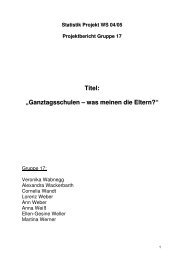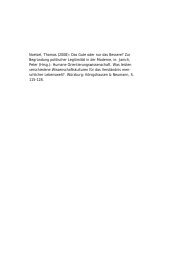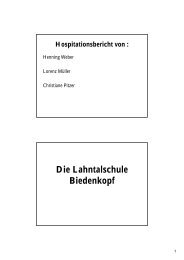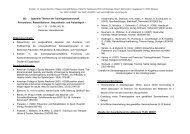of K - Philipps-Universität Marburg
of K - Philipps-Universität Marburg
of K - Philipps-Universität Marburg
Create successful ePaper yourself
Turn your PDF publications into a flip-book with our unique Google optimized e-Paper software.
4<br />
Daśāvatāracarita (Ananta is mentioned, but Kalaśa is the ruling king). DATTARAY (1974), p. 71,<br />
suggests that “the important period <strong>of</strong> K¤emendra’s literary activity, as may be evident from an<br />
inquiry into the chronology <strong>of</strong> the poet’s work, almost synchronises with the period <strong>of</strong> Ananta’s<br />
sovereign rule and continues for a few years more after the king’s formal abdication in favour <strong>of</strong> his<br />
son, Kalaśa”.<br />
It might be interesting to mention the peculiar features <strong>of</strong> two satirical works: Deśopadeśa and<br />
Narmamālā. Both works were found together in the same manuscript and share many allusions,<br />
witty characters and references to political and social issues. It seems that both works were written<br />
at a time when K¤emendra was concerned about the corruption and moral decline <strong>of</strong> religious authorities,<br />
and this leads me to believe that<br />
“Bibliography<strong>of</strong>K¢emendra’sMinorWorks”<br />
and Deśopadeśa were conceived as kinds <strong>of</strong><br />
“romans a clef” (Schlüsselromane). Deśopadeśa is cited in his Kavikahābharaa V.1.40, but the<br />
co-name Vyāsadāsa is not mentioned. SATO suggests in his introduction to his translation (1994, p.<br />
8) that the Deśopadeśa is composed <strong>of</strong> “condensed stories” in independent verses (muktakas) with<br />
ridiculing and satirical elements. As K¤emendra does not give any examples <strong>of</strong> good conduct, so,<br />
pace SATO, the poem appears to be the product <strong>of</strong> an early stage <strong>of</strong> K¤emendra’s career as a poet.<br />
The Narmamālā<br />
is not mentioned in his poetical treatises, and K¤emendra is not referred to by his<br />
co-name Vyāsadāsa.<br />
Narmamālā<br />
But in the edition <strong>of</strong> RĀGHAVĀCHARYA (1961), pp. 321, 335, 346, the editors may have added to<br />
the colophon “iti śrīvyāsadāsāparākhyakemendraviracitāyā narmamālāyā ...” at the end <strong>of</strong> the<br />
chapters (parihāsas). In Narmamālā<br />
the the author attacks the powerful caste <strong>of</strong> clerks and scribes<br />
(kāyastha) as agents <strong>of</strong> the corrupt <strong>of</strong>ficial machinery <strong>of</strong> his time. The king Ananta having killed the<br />
kāyastha-demons (I. 3-4, I.9) is compared with Vi¤u. In her English translation <strong>of</strong> Narmamālā<br />
the<br />
(1999), p. 6 & (2005), pp. XIV-XV) BALDISSERA suggests:<br />
“K¢emendra is generally believed to be the author <strong>of</strong> this satire, for Narmamālā the has many stylistic,<br />
lexical and narrative affinities with other works <strong>of</strong> his, in particular with his satires. The<br />
mātkāSamaya-<br />
and Deśopadeśa, for instance, are works that share many situations and characters with the<br />
Narmamālā. The Kavikahābhāraa [sic], on the other hand, a work on poetics, shares with the<br />
mamālāNar-<br />
many interesting terms (kāmatattva, ghaī, etc.).”<br />
MAHAJAN (1954), pp. 24-25, interprets the introductory verses in the prologues, holding that the<br />
period in which K¤emendra wrote the Deśopadeśa and Narmamālā, fits in well with the time <strong>of</strong><br />
king Ananta’s reformatory success after accession to the throne in 1028 A.D.:<br />
“Some discussion is required to understand the period <strong>of</strong> composition <strong>of</strong> D.U. and N.M. D.U. is clearly<br />
a series <strong>of</strong> discourses on important topics for the benefit <strong>of</strong> the students. When it was written,<br />
K¢emendra must have had some students under him; otherwise why should he write for students?<br />
Similarly N.M. refers to king Ananata’s [sic !] request to compose a satirical poem on the ways <strong>of</strong> Kāyastha[s]<br />
who were not longer in power then. (hāsāyātīta kāyastha-carita [cf. Narmamālā, first<br />
parihāsa, verse 6.]) Which was this period in the history <strong>of</strong> Kashmir when Kāyasthas were not powerful?<br />
That is really a vexing question. King Ananta came to the throne in 1028 A.D. and there was no<br />
peace till he defeated the Dards. King Ananata [!] was regarded as a benign ruler when he ruled sagaciously<br />
under the strict supervision <strong>of</strong> queen Suryamati [!]. This period seems to have come at least 10<br />
to 15 years after his accession to the throne, and therefore, the composition <strong>of</strong> N.M. must also be during<br />
he same period. Thus D.U. and N.M. must have been written after or about 1040 A.D. or 1045<br />
A.D.”<br />
Luckily, as mentioned above, in some poems K¤emendra provides an approximate calculation in the











